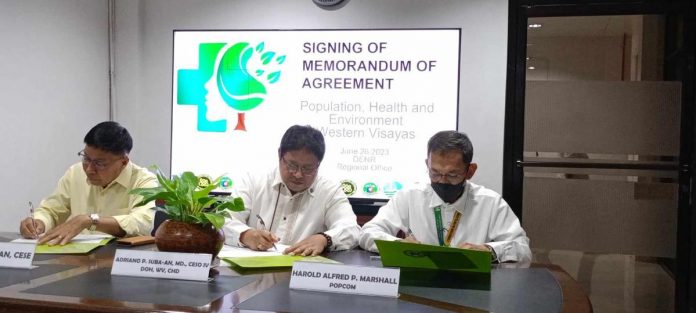
ILOILO City – Using the population, health and environment (PHE) framework approach, three regional government agencies in Western Visayas are joining hands to help and empower marginalized communities.
The Department of Health (DOH) Region 6, Department of Environment and Natural Resources (DENR) Region 6 and Commission on Population and Development (CPD) Region 6 will bring government services, on top of the regular ones, down to the communities, according to DOH-6 director Dr. Adriano Suba-an.
The three agencies recently inked a memorandum of agreement (MOA) for the “Heal the Earth” program using the PHE approach.
Initially, they were eyeing the communities in Calinog town for their program which will be carried out on July 27. Suba-an said they are set to discuss this with Gov. Arthur Defensor Jr.
Under the program, DOH-6 will be the lead agency on the provision of technical assistance on the delivery of health services in collaboration with the provincial and city health offices to strategically identify mechanisms to address health concerns by addressing inequities and social determinants of health.
For one, Suba-an said they will bring their mobile clinic dubbed “kNOwTell on Wheels.”
The mobile clinic can offer health services and diagnostic tests such as human immunodeficiency virus (HIV) testing, screening for presumptive tuberculosis (TB), diabetes, hypertension, and other non-communicable and infectious diseases prevention and control including mental health gaps.
Suba-an stressed that it is not only a one-time program because they will continue collaborating with the local government units (LGU) of Calinog and monitor the situation of the communities.
“We are creating a certain norm, hindi siya mangyayari kung isahan lang. So on top of the regular services, we are collaborating with the LGU, babalik-balikan po ‘to ng DOH and we have to establish our target kung ilan ‘yung ma-screen sa kanila, ilan ang i-manage, ilan ang bibigyan ng gamot or referral,” he said.
On the part of the CPD, Regional Director Harold Alfred Marshall said that among others, they will conduct adolescent health classes and profiling of the adolescent population to pinpoint those who have signs of red flag such as suicidal tendency, engaged in risky sexual behavior, smoking, drug, and bullying, among others.
“We will be working also with LGU, we will attempt to provide them enough capacity development concepts wherein we can assist them in preparing and looking into their own data,” he added.
“Kami sa PopCom, with DOH and DENR, we really need to put our heads together and ensure nga ang development mabatyagan gid sang pumoluyo. This is also our contribution to the “Ambition Natin 2040” nga nobody is left behind and everybody will enjoy the fruits of development,” he added.
The DENR-6, on the other hand, will be providing technical assistance. DENR-6 regional executive director Livino Duran said since they have already established several interventions in Calinog, they will work on the enhancement of the said interventions.
“We really wanted to enhance this, hindi pwede na pabayaan. With the integration now ng ating mga health services and population management and development doon sa area, so probably we can now enhance government services in Calinog,” said Duran.
Gina’s case
During the MOA signing, the agencies shared the case of a certain Gina from Calinog who lived five kilometers away from the nearest barangay health station.
The barangay where she lived is prone to flooding and landslide and the community has poor health seeking and promotive behaviors.
Gina lived with her parents – 75-year-old father under TB treatment and 65-year-old mother with pneumonia.
At 43, Gina was pregnant and already had six children including a 10-month old baby who has a polio.
Two of her youngest children are malnourished, have infected dental caries, and frequent diarrhea and poor hygiene.
One child also has development problem due to metabolic disorder while her eldest child was already pregnant at 15 years old and acquired sexually transmitted infection.
Her husband is smoking, drinking alcohol, and recently lost his job due to coronavirus disease 2019 (COVID-19).
Gina herself had chronic hypertension. During her pregnancy, she had only one prenatal checupt during her first trimester.
Unfortunately, Gina died due to eclampsia and hypovolemic shock giving birth to her seventh child at home though an assistance of a hilot.
Suba-an said the case of Gina highlights the possible scenario if there are people who are left behind not able to access the supposed services to be given to them.
“Ang kwento ni Gina ay kwento din po na ibang pamilya… most of these families belong to the invisible population, hindi nakikita… Ito ‘yung gusto nating ilitaw na every Filipino family is important. They don’t have to remain forever as invisible na hindi napapansin, dapat lahat nabibigyan ng serbisyo and the only way for them to access it is to make them informed,” Suba-an emphasized.
“That is why ang national government agencies are going directly to them, talking to them, sharing with them information which is important for them to know…” he added./PN



